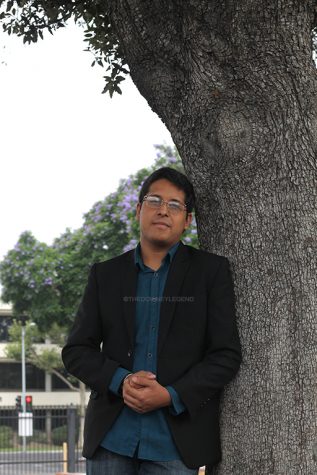How “The Good Place” Redefines Morality and Humanity
February 26, 2018
Mortality and morality work in tandem – mortality gives rise to morality and in turn, morality dictates the proper conduct for humans. But often times, morality and its subsequent answers are tragic and desolate; a concept that is reduced two extremes: heaven and hell, good and bad, right and wrong. Although society and religion have conditioned the binary idea of good and bad to be truth, are actions as black and white as they are stated to be? Is the margin for improvement so minimal?
“The Good Place,” an existentialist comedy created by Michael Schur, takes the simple premise of the afterlife and subverts the societal norms of “good” and “bad” while infusing hope and optimism in a concept associated with the bleak and desolate.
Season one of ‘The Good Place” redefines hell as Michael, the architect of the neighborhood the four main characters of the show inhabit, transforms the generic and exaggerated idea of a torture chamber into a perfect utopia in which people can fly, soulmates are real, and yogurt is aplenty. The torture facet of “The Good Place” falls on the humans – Eleanor, Chidi, Tahani, and Jason – as they are pit against themselves to make each other miserable without their acknowledgement of the events at hand. What they are told to be paradise slowly becomes a cesspool of their deepest anxieties as the season progresses. Eleanor is trapped in web of ethical principles leading her away from her self-preservational tendencies; Chidi, a professor of ethics, is wracked by the moral implications of helping a selfish person; Tahani is forced to confront her obsessive need to be “perfect;” and Jason, well, just struggles to be a competent person. Societal expectations would have predicted the four humans to turn on each other but instead, they help each other to Michael’s surprise.
Chidi, despite his initial hesitance, helps Eleanor become a better person through ethics lessons about various moral principles, but each principle taught has an inherent problem present. Utilitarianism, though ideal, can justify a variety of bad actions if the end result is good. Moral particularism, which states that certain actions are ethical in certain situations, can be seen as a cheap way of evil as it relies heavily on the perception of the individual. Each ethical principle seems perfect, but never is, forcing Eleanor to reevaluate her simplistic view on morality — there might be a correct choice, but the answer is never easy, and that is how it is meant to be.
Nothing is perfect, everything has a flaw. The Good Place turned out to be the Bad Place. Every moral principle taught by Chidi was flawed in some sense. But instead of taking the information of the world at face value, each human persisted despite the notions that told them the opposite and surpassed the labels placed upon them. Considered selfish on Earth, Eleanor proved to herself her capability to be good and selfless. Believing himself to be good due to his profession, Chidi came to terms with the indecisiveness that plagued him on Earth. Corrupt motivations aside, Tahani grew to overcome her reliance on the opinion of others. Making rash decisions on a consistent basis, Jason grew to comprehend the ramifications of his actions.
The changes each character experienced weren’t short-term even if the neighborhood they inhabited was rebooted; after each reboot – approximately 800 as stated in the show – the same development happened without fail. Even Janet, a Siri-like AI assistant, developed emotion, an ability unknown to other Janets present in the afterlife. She grew past her label as an “anthropomorphized vessel of knowledge” and became something special: she became human. Michael, a literal demon born to torture humans, grew to understand the complexity and fluidity of human actions. He understood that abstract concepts of “good” and “bad” are not quantifiable as he was conditioned to believe – he saw first-hand that humans have the capability to improve, even if posthumously so. Growth is not a solitary action though, as the humans relied on each other to improve.
What do we owe to each other? A single question posed by T.M Scanlon in 1998 and one that acts as a driving force for the humans’ growth on “The Good Place.” The theory of contractualism doesn’t necessarily state a binary stance on human actions, but it does ask people to rethink their responsibility to one another. Is it something as tangible as a monetary reward? Something as simplistic as keeping a promise? Or is it something more meaningful, like a connection? A connection among each other to evolve as one without letting one fall behind. Eleanor and Chidi exemplify such connection as they re-encounter themselves in each reboot of the neighborhood; even in the following simulations where both are separated, they always manage to find each other. It is not until they are separated with no method of reconnecting that Eleanor suffers, but not in the Bad Place as would be expected. After she is sent back to Earth in the second season to analyze her capability for growth without knowledge of the afterlife, Eleanor demonstrates some growth but regresses into her old ways. Michael sees this but rather than remaining a bystander, he nudges Eleanor in the right direction: he helps her find Chidi. They owe each other not a promise, but a responsibility to become better people.
Improvement is optimism embodied. It is the chance for one to grow beyond the limits society has imposed indirectly, the chance to turn a new leaf when all seems lost. And in this manner, “The Good Place” finds humanity in the afterlife. It reevaluates the rigid, superficial concepts its foundation is based on while leaving audiences with a lingering sense that humanity is not as destructive as it seems to be.



